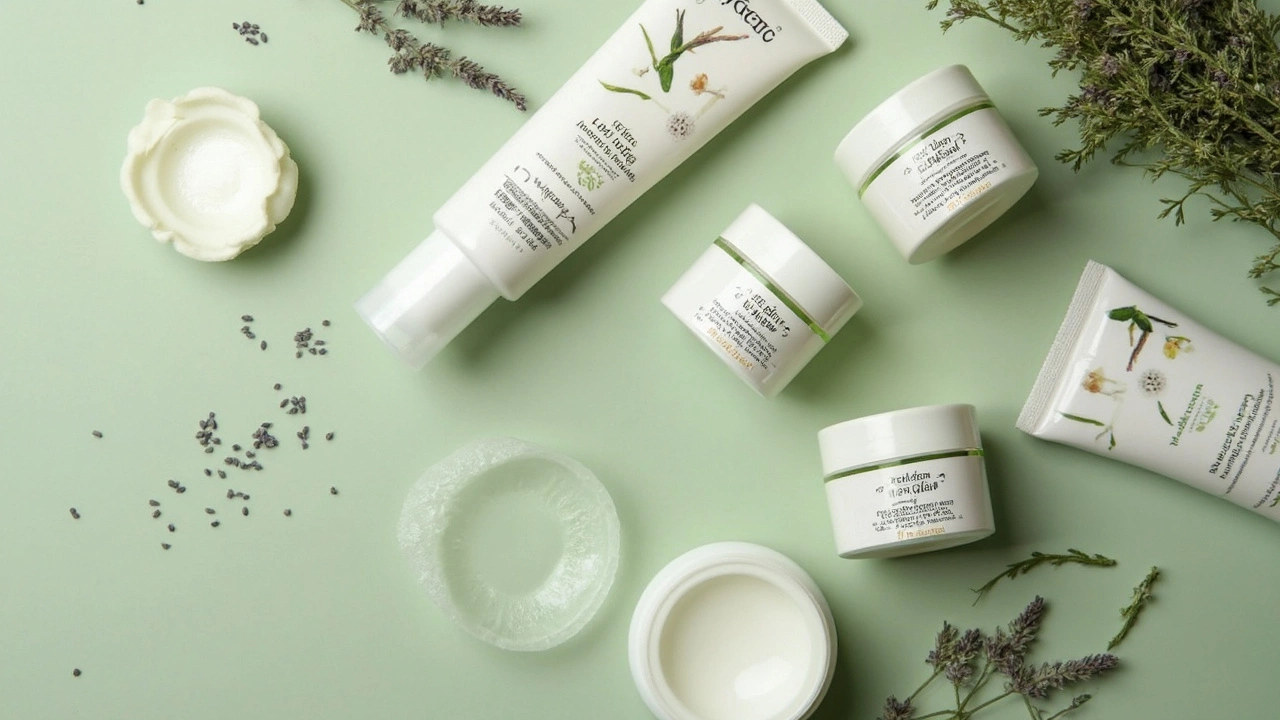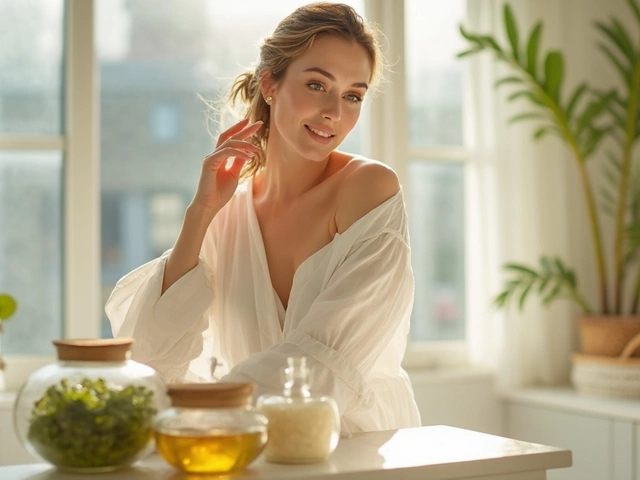If you’ve ever stood in the beauty aisle overwhelmed by words like 'clean,' 'organic,' or 'non-toxic,' you’re not alone. The world of skincare gets confusing fast, and companies often slap on those words without solid proof. That’s why knowing what truly non-toxic means is the only real way to keep your skin safe.
In simple terms, non-toxic skincare skips harsh chemicals, sneaky irritants, and anything known to mess with your health—even in small amounts. But here’s a reality check: 'non-toxic' isn't a regulated label in most countries. Companies can use it however they want. So if you want real non-toxic products, you’ll need to get a bit label-savvy and ingredient-aware.
- What Does 'Non-Toxic' Really Mean?
- Common Toxic Ingredients to Dodge
- Truly Safe Ingredients You Want
- How to Read and Trust Labels
- Simple Swaps and Easy Routines
What Does 'Non-Toxic' Really Mean?
People toss the phrase 'non-toxic' around in skincare all the time, but there’s no government rule that decides what counts as non-toxic, especially in places like the U.S. or Europe. It really just means a product doesn’t have ingredients known to cause major health issues, like skin irritation, hormone disruption, or worse when used as directed. You’d think every product would avoid those, right? Not even close.
The reality is that a lot of regular beauty products on store shelves can legally contain small amounts of toxic substances like parabens or phthalates. That’s why people looking for non-toxic skincare often focus on products that keep out the most risky stuff, even if the law hasn’t caught up yet. Key things non-toxic products usually skip include certain synthetic fragrances, colors, and preservatives linked to irritation or health risks.
Here’s what that looks like in practice:
- No harsh sulfates (the stuff that makes regular face wash super foamy, but dries your skin or causes redness)
- No parabens (these are cheap preservatives that show up in a ton of products, but have links to hormone disruption)
- No phthalates (you’ll find these almost everywhere as 'fragrance,' but they’re tied to allergies and more serious health concerns)
- No synthetic colors or strong artificial scents
- No formaldehyde and other sneaky preservatives
One thing organic brands get right is full ingredient lists—nothing hidden. Non-toxic also means being transparent, so you know exactly what’s in the bottle. A product might be safe even if it isn’t stamped 'organic' everywhere, but if the brand keeps things clear and avoids the known nasties, you’re on the right track.
What’s wild is that according to the Environmental Working Group, the average adult uses nine personal care products a day, and those can contain over 120 unique chemicals—many untested for long-term safety. That’s a lot for anyone’s skin to handle!
Sticking to organic skincare with clearly non-toxic labels isn’t just a fad. It’s a practical way to dodge the most common problem ingredients and treat your skin with stuff that actually helps, not harms.
Common Toxic Ingredients to Dodge
There’s no way around it—if you want truly non-toxic skincare, you’ve got to dodge some common troublemakers. Most of the worst stuff is hiding in plain sight, even in products that claim to be natural. Learning a few key names makes a big difference for your skin and your health.
- Parabens (like methylparaben and propylparaben): Used as preservatives, these are linked to hormone disruption. See a word ending in -paraben? Toss it back on the shelf.
- Sulfates (SLS, SLES): These make products foamy but often end up irritating skin and stripping away natural oils.
- Phthalates: Almost always hiding under “fragrance” or “parfum,” phthalates mess with hormones and may be harmful long-term. If you see the word “fragrance” with no explanation, that’s a red flag.
- Formaldehyde & formaldehyde-releasing ingredients (like DMDM hydantoin): They keep products stable but can trigger allergies and are considered carcinogenic.
- Triclosan: Sometimes found in cleansers and toothpaste, it’s been linked to hormone issues and even antibiotic resistance.
- Oxybenzone & chemical sunscreens: These are common in sunscreens but are known for irritating skin and can be absorbed into your body.
- Artificial dyes and scents: Extra color or perfume often mean extra irritation, especially for sensitive skin.
Check out how often these ingredients pop up in drugstore products:
| Ingredient | How Often in Mass Market Skincare (%) |
|---|---|
| Parabens | 78% |
| Sulfates | 63% |
| Phthalates | 65% |
| Triclosan | 22% |
| Oxybenzone | 41% |
When you shop for natural skincare or organic skincare, do a quick scan for these. If you skip one thing in your routine, this swap can do more for your skin than any fancy serum ever could.

Truly Safe Ingredients You Want
Picking out non-toxic skincare isn’t about having the shortest ingredient list possible—it’s about knowing what’s actually safe and good for you. Some ingredients get hyped for being “natural,” but not all natural things are automatically better for your skin. It’s all about research and choosing science-backed options that nourish without risk.
When you look for organic skincare, there are a few ingredients that consistently top the safe-list based on years of dermatology research and experience. You’ll spot these in many trusted products:
- Aloe Vera – Soothes, calms redness, and hydrates. It’s been used for ages for sensitive skin.
- Shea Butter – Locks in moisture and creates a barrier. Great for dryness and healing.
- Jojoba Oil – Closest to your skin’s own oil (sebum) and non-comedogenic, so it won’t clog your pores.
- Squalane (from plants) – Lightweight hydration with zero greasiness. It’s super gentle, even for baby skin.
- Green Tea Extract – Full of antioxidants, helps fight irritation, and is linked to reduced sun damage.
- Colloidal Oatmeal – Relieves itching for sensitive or eczema-prone skin.
- Rosehip Oil – Loads of vitamin C for brightening and reducing scarring.
For a reality check on why these matter, check what Dr. Whitney Bowe, a board-certified dermatologist, says:
"Less is more when it comes to safe skincare. The best ingredients are simple, well-studied plant oils, butters, and extracts that don’t irritate."
Avoid getting caught up in buzzwords. If you ever wondered whether a fancy-sounding extract is worth the risk, here’s a quick breakdown of star ingredients that keep things safe and straightforward:
| Ingredient | Main Benefit | Good For |
|---|---|---|
| Aloe Vera | Calms & hydrates | Sensitive skin |
| Shea Butter | Moisturizes | Dry, flaky skin |
| Jojoba Oil | Balances oil, protects | Oily, acne-prone skin |
| Green Tea Extract | Reduces redness, fights free radicals | All skin types |
One tip: Always patch test even these safe picks, especially if you have allergies. 'Natural' doesn’t guarantee zero reactions, but sticking with these tried-and-true ingredients puts you ahead in your search for true non-toxic skincare.
How to Read and Trust Labels
Picking non-toxic skincare isn’t just about grabbing the first bottle that says “natural” or “organic” on the front. Most of the time, those words aren’t tightly regulated. In fact, the term “organic” might mean just one ingredient is organic, not the whole product. That’s why flipping the bottle around and checking the full ingredient list matters a lot more than the fancy front label.
The first trick: look for short ingredient lists. If you see a bunch of long, hard-to-pronounce names, that’s a red flag. Some of those could be skin irritants, chemical preservatives, or just unnecessary fillers.
It’s also smart to check for third-party certifications. Seals from organizations like USDA Organic, Ecocert, or COSMOS actually mean someone has checked that the product meets a real, enforceable standard. If you spot these badges, it usually means the product lines up with stricter rules on what can and can’t be inside.
- USDA Organic: At least 95% certified organic ingredients.
- Ecocert: Limits on synthetic and petrochemical ingredients.
- COSMOS: Checks for sustainable sourcing and non-toxic formulas.
If a product uses a fragrance, pause for a sec. "Fragrance" can be code for dozens of hidden chemicals, some of which are linked to skin allergies or hormone disruption. Safer products spell out every component or just use essential oils (which you’ll see in the ingredient list).
Don’t ignore the order of ingredients, either. Ingredients are listed from the highest to the lowest percentage. Key actives or plant ingredients should show up near the top—not buried at the bottom.
| Claim | What It Actually Means |
|---|---|
| "Natural" | No official rule—could mean anything. |
| "Organic" | Might mean only one ingredient is certified organic. |
| "Hypoallergenic" | No FDA requirement or standard. |
| "Dermatologist Tested" | No proof it’s safer—just that a dermatologist has tested it (not necessarily on humans). |
Bottom line? Trust your own detective work more than big, bold claims. Stick with products that are transparent about every ingredient and carry real organic or non-toxic skincare seals. Once you get in the habit of flipping bottles and double-checking, you’ll get a lot better at avoiding junk and filler in your daily routine.

Simple Swaps and Easy Routines
Switching to non-toxic skincare doesn’t have to mean tossing your whole shelf and starting from zero. Swapping out just a few common products for safer ones can change your routine—and your skin health—without making things complicated.
Here are swaps anyone can do right away:
- Face Cleanser: Swap harsh foaming cleansers (think sulfates) for gentle options made with ingredients like organic aloe, coconut oil, or olive oil. These keep your skin's barrier happy instead of stripping everything off.
- Moisturizer: Instead of picking something with 'fragrance' or unpronounceables, go for simple moisturizers made with shea butter, jojoba oil, or squalane. Your skin will recognize these, and they’re less likely to cause irritation.
- Sunscreen: Chemical sunscreens often have oxybenzone and octinoxate. Swap those for mineral sunscreens with zinc oxide or titanium dioxide instead. These options protect just as well and skip the hormone disruptors.
- Body Wash and Lotion: Trade out anything with parabens or artificial colors for plant-based products with coconut oil, oat extract, or calendula.
- Serums: For actives like Vitamin C or hyaluronic acid, look for brands that use water-based or oil-based formulas with only a few ingredients and no fillers.
Don’t overthink your routine. Stick to a simple setup:
- Gentle cleanser morning and night
- Moisturizer suited for your skin type
- Mineral sunscreen every morning
- Hydrating serum or facial oil as needed
Shop from brands that clearly list every single ingredient, and look for basic eco-certifications like USDA Organic, COSMOS, or EWG Verified. Even a 2023 survey found that people who simplified to just two or three organic skincare products saw fewer breakouts and less redness within four weeks.
| Swap This | For This |
|---|---|
| Sulfate Face Wash | Organic Aloe Cleanser |
| Chemical Sunscreen | Mineral Zinc Sunscreen |
| Fragranced Body Lotion | Shea Butter Lotion |
One final tip: ditch products that promise miracle results and stick with basics that actually feel good to use. Often, the simplest routine with the cleanest ingredients gives you the healthiest skin.


